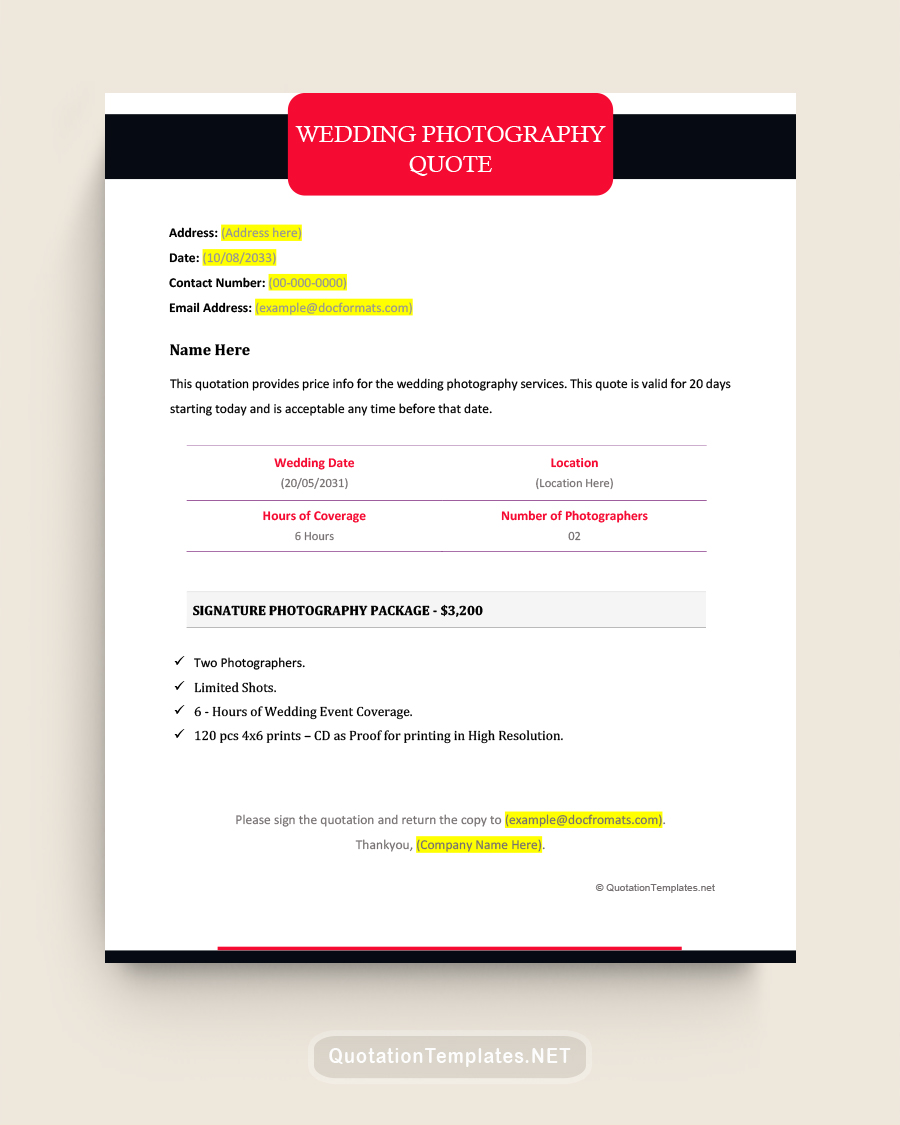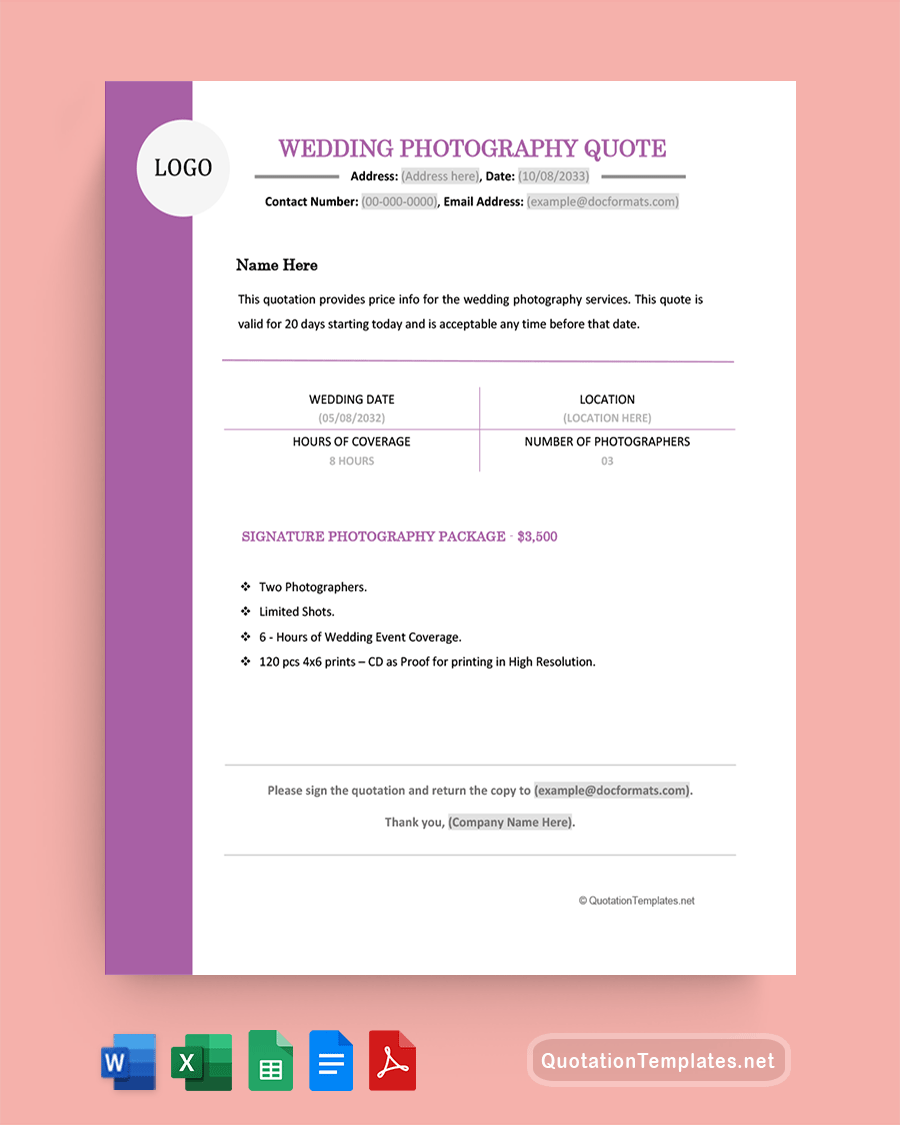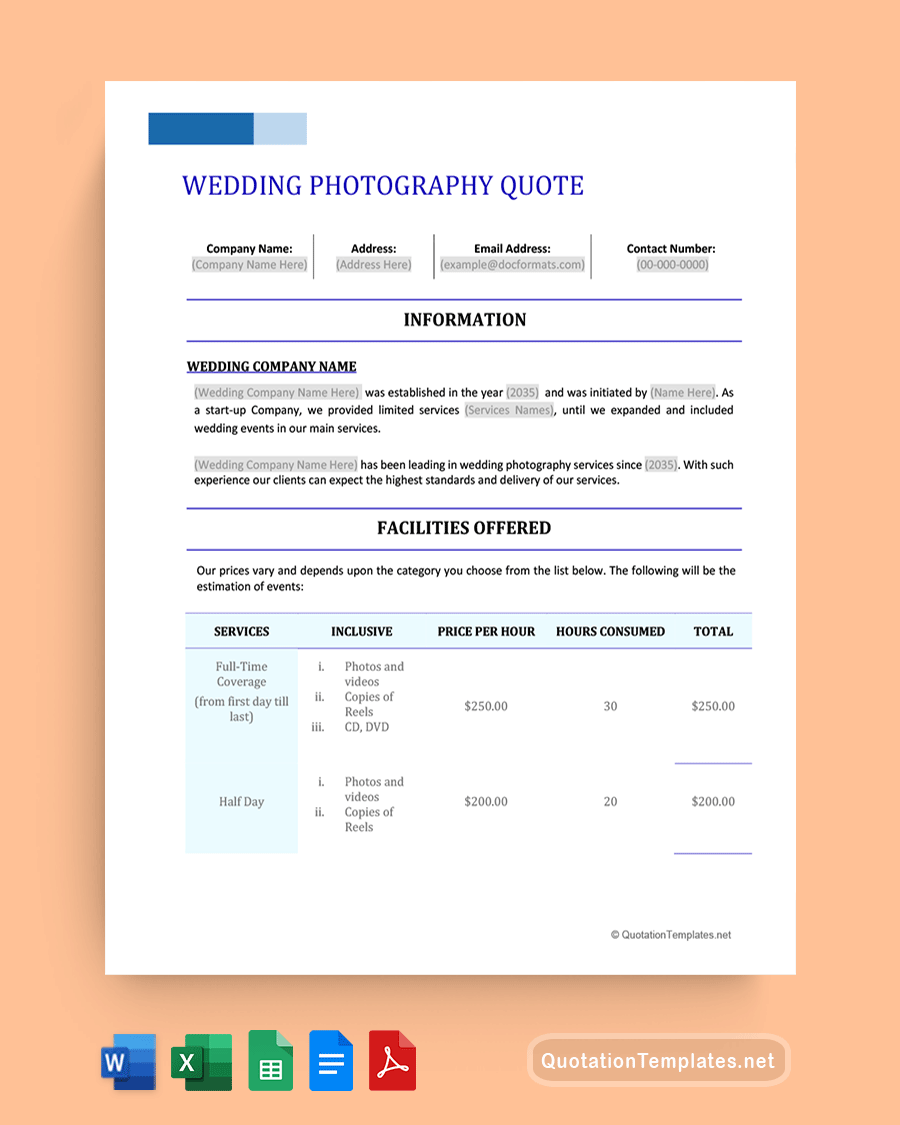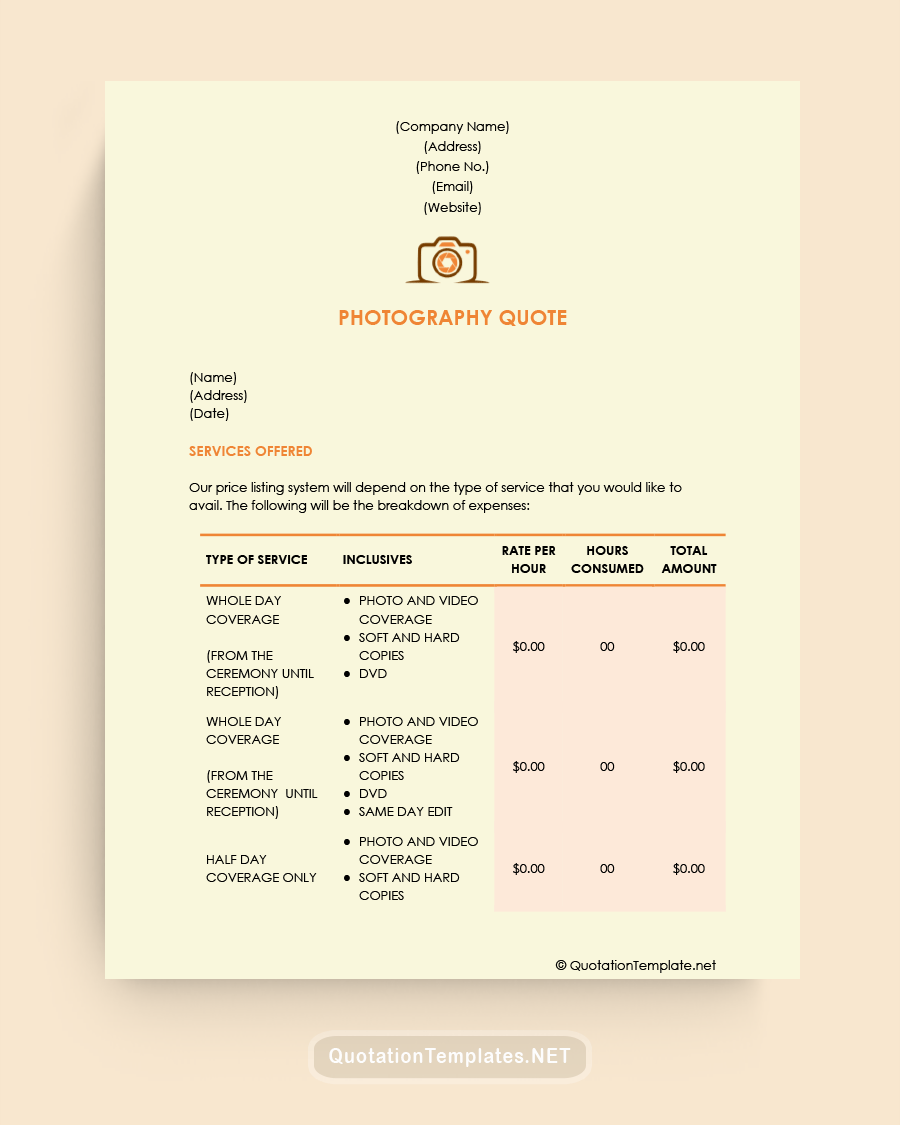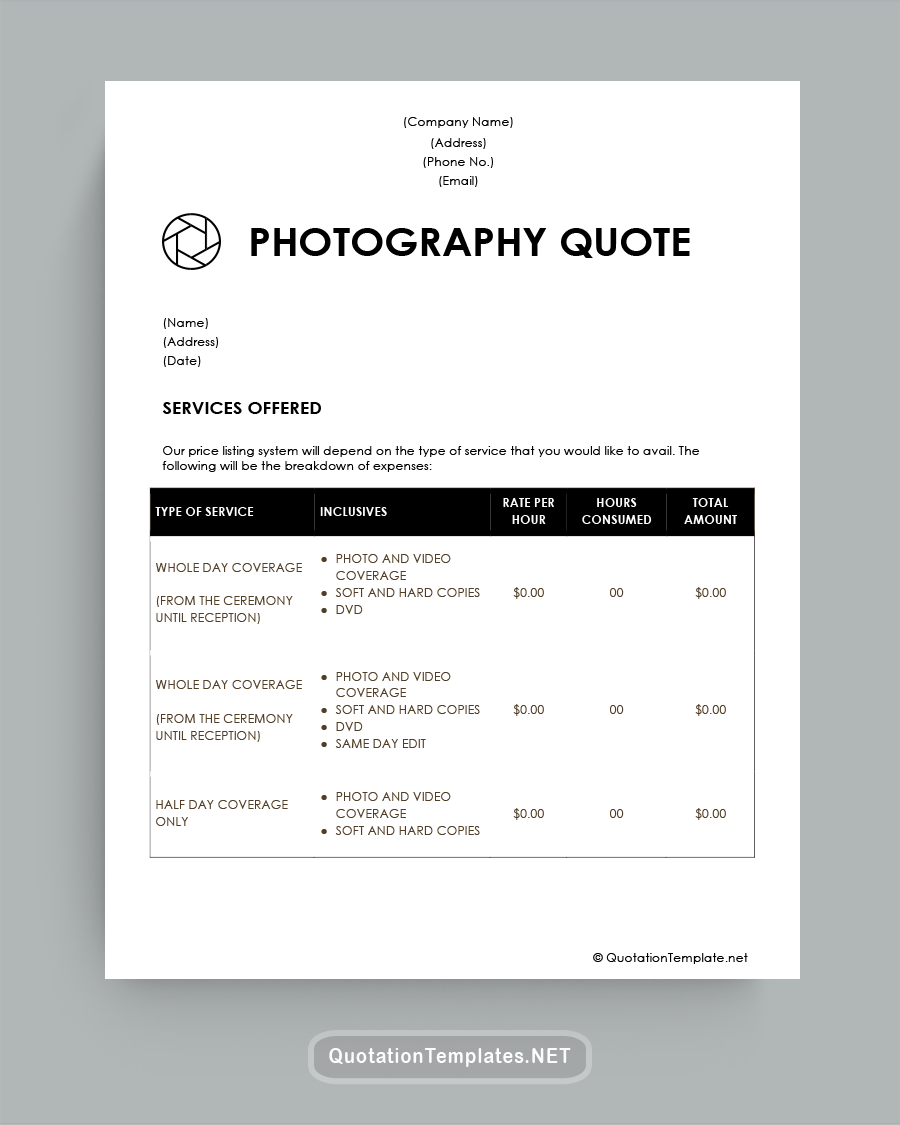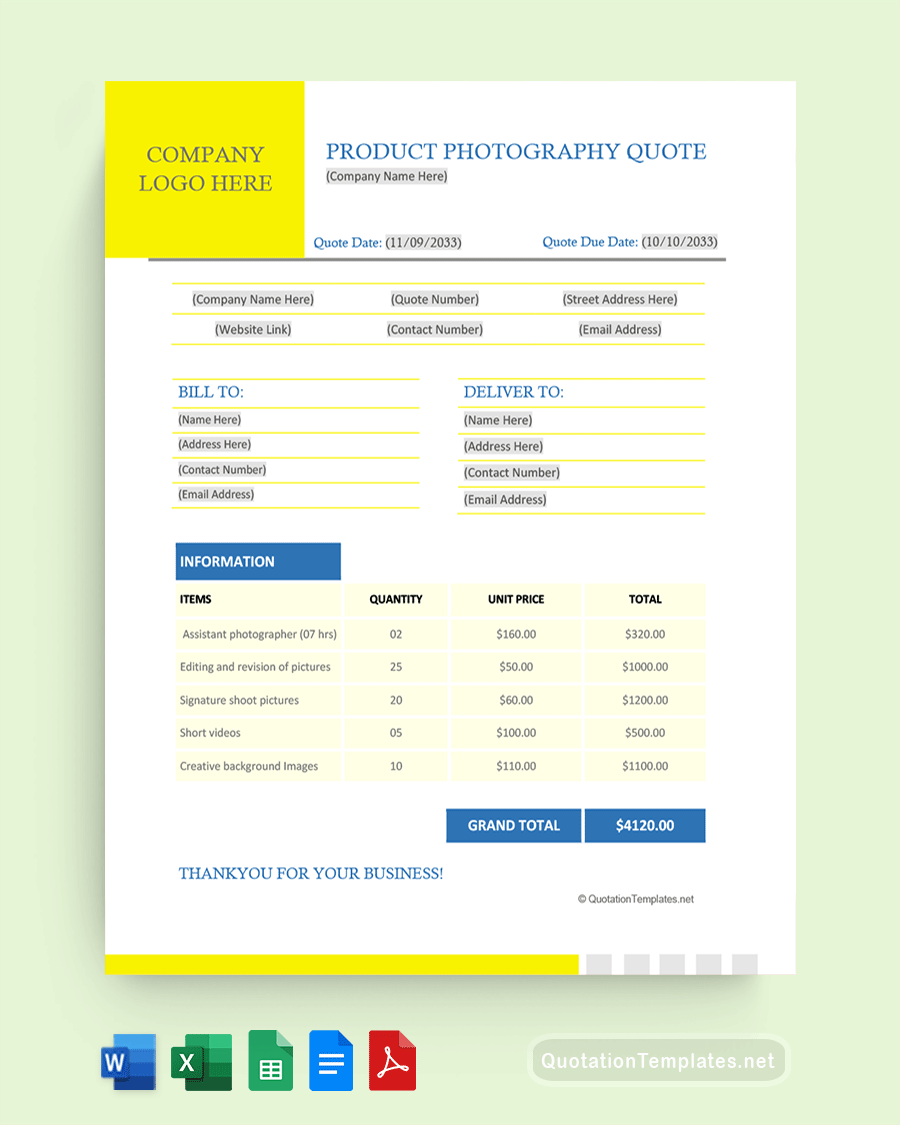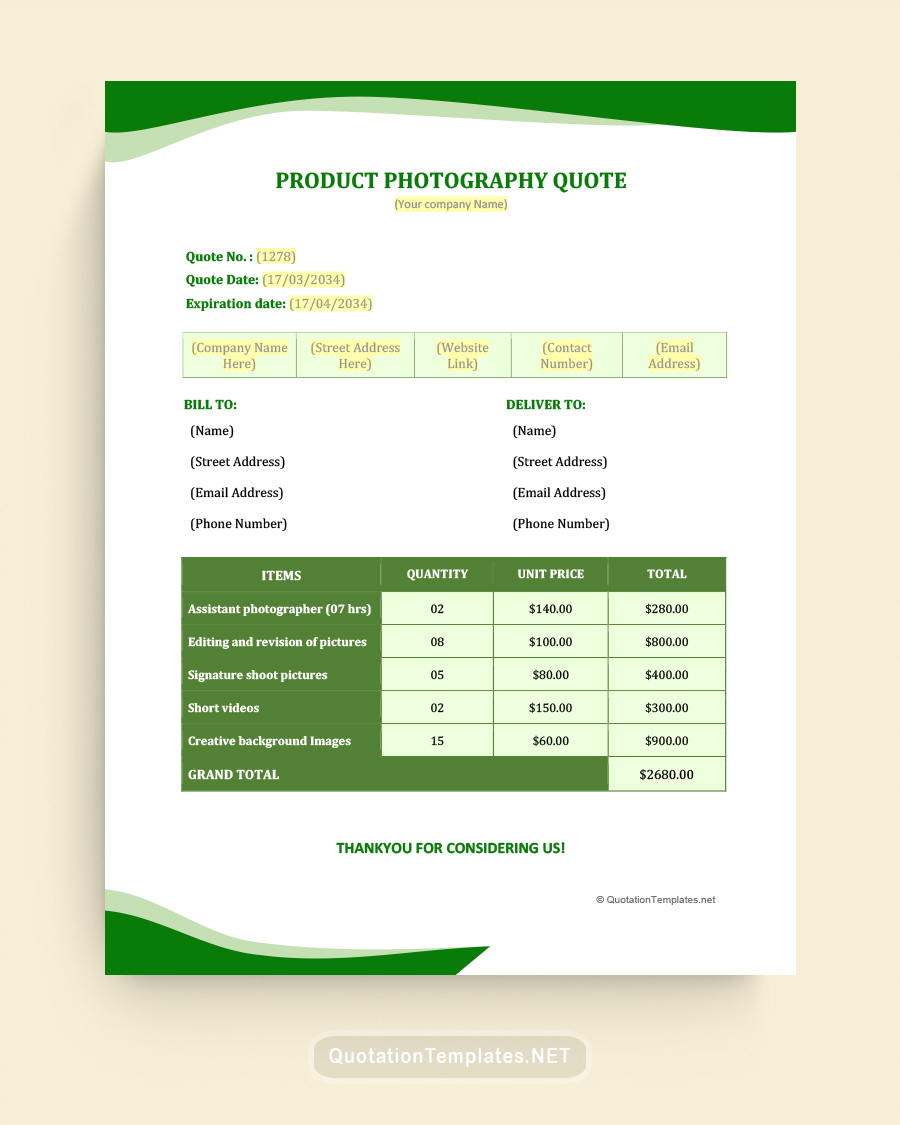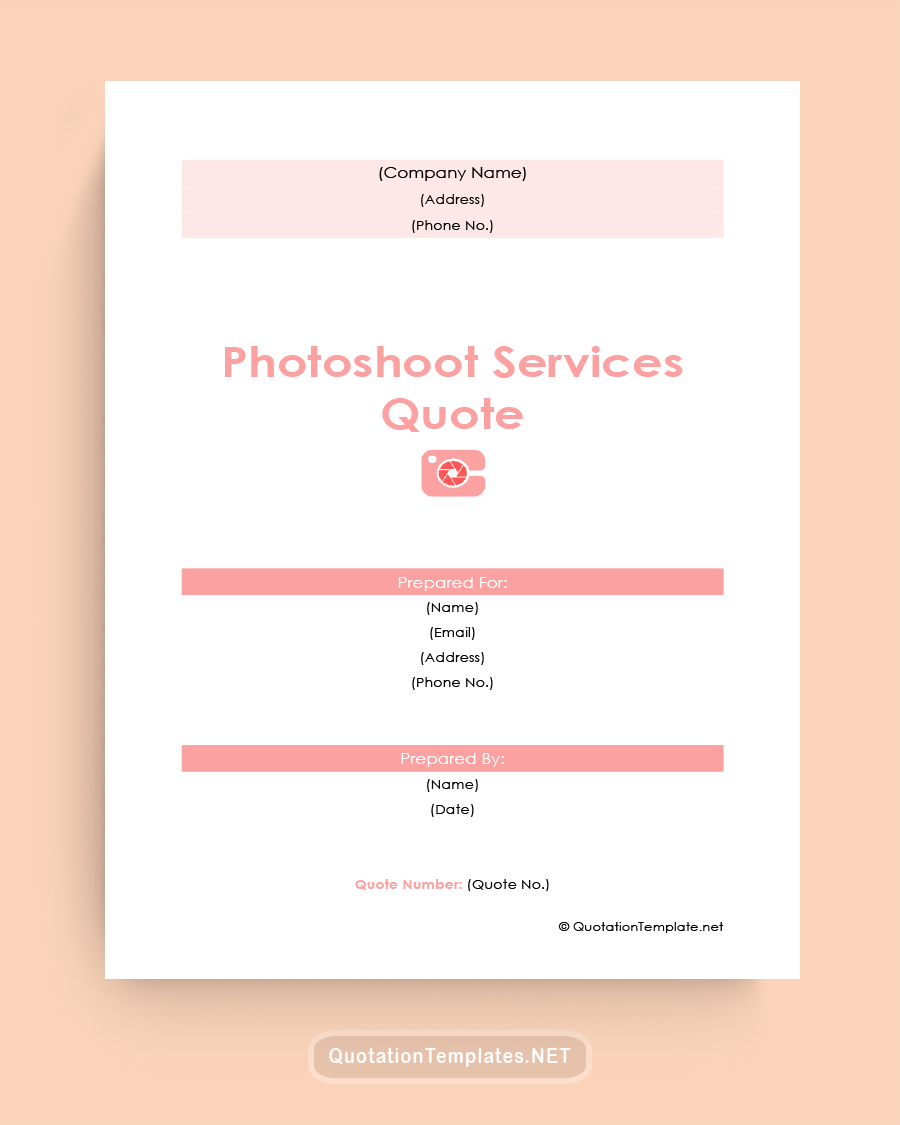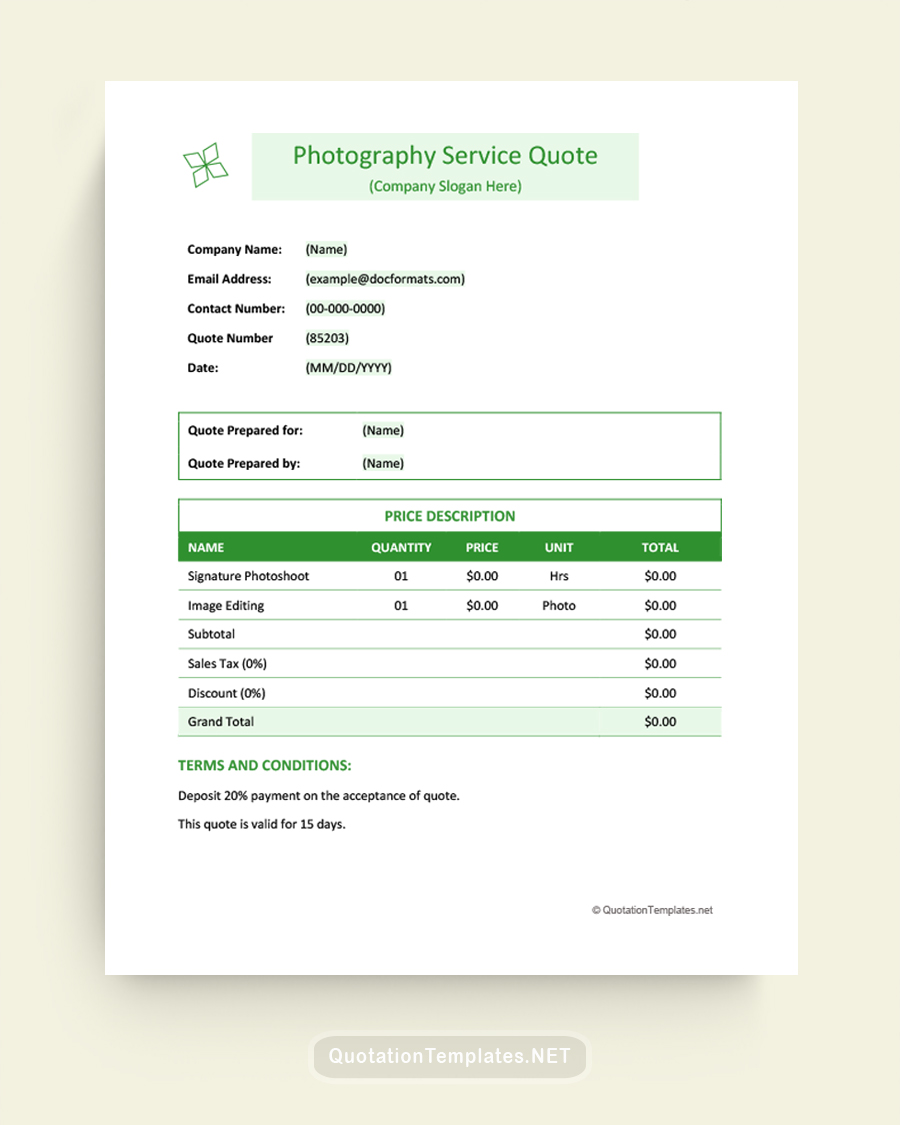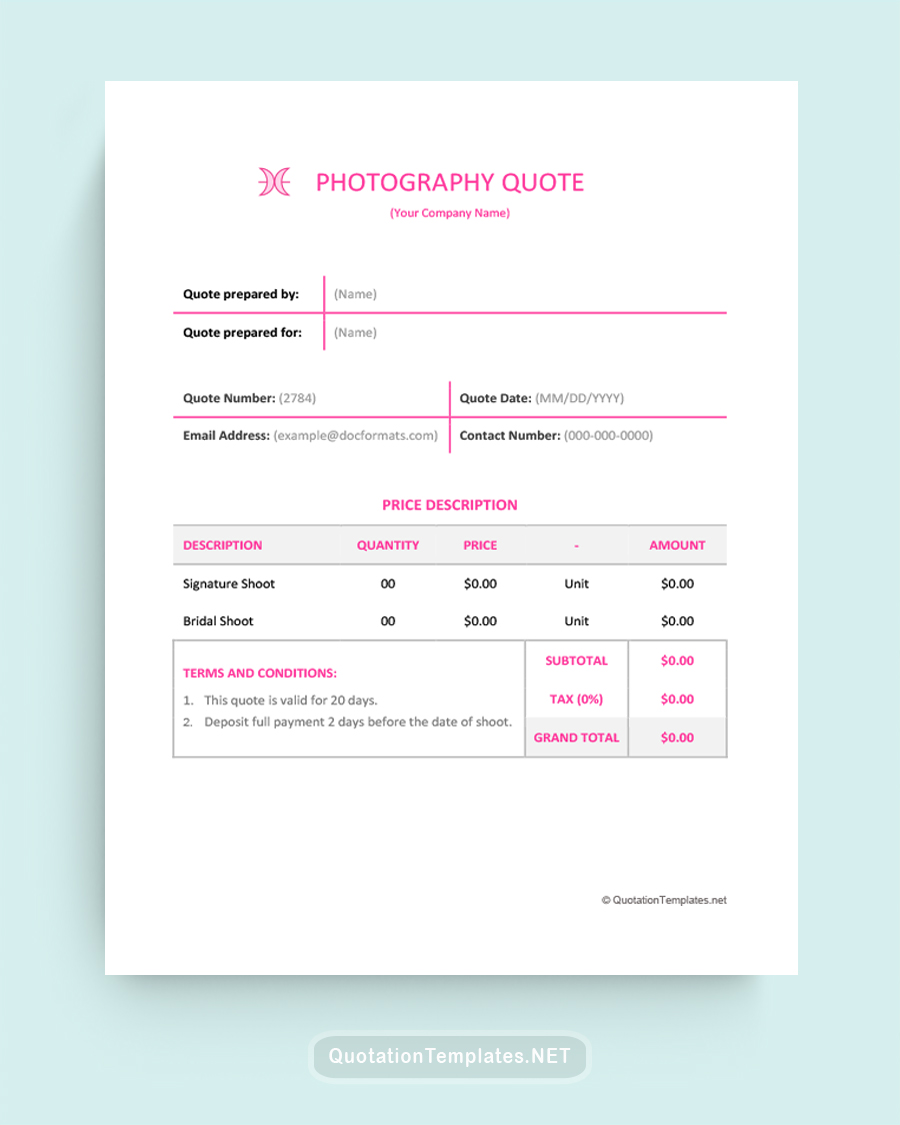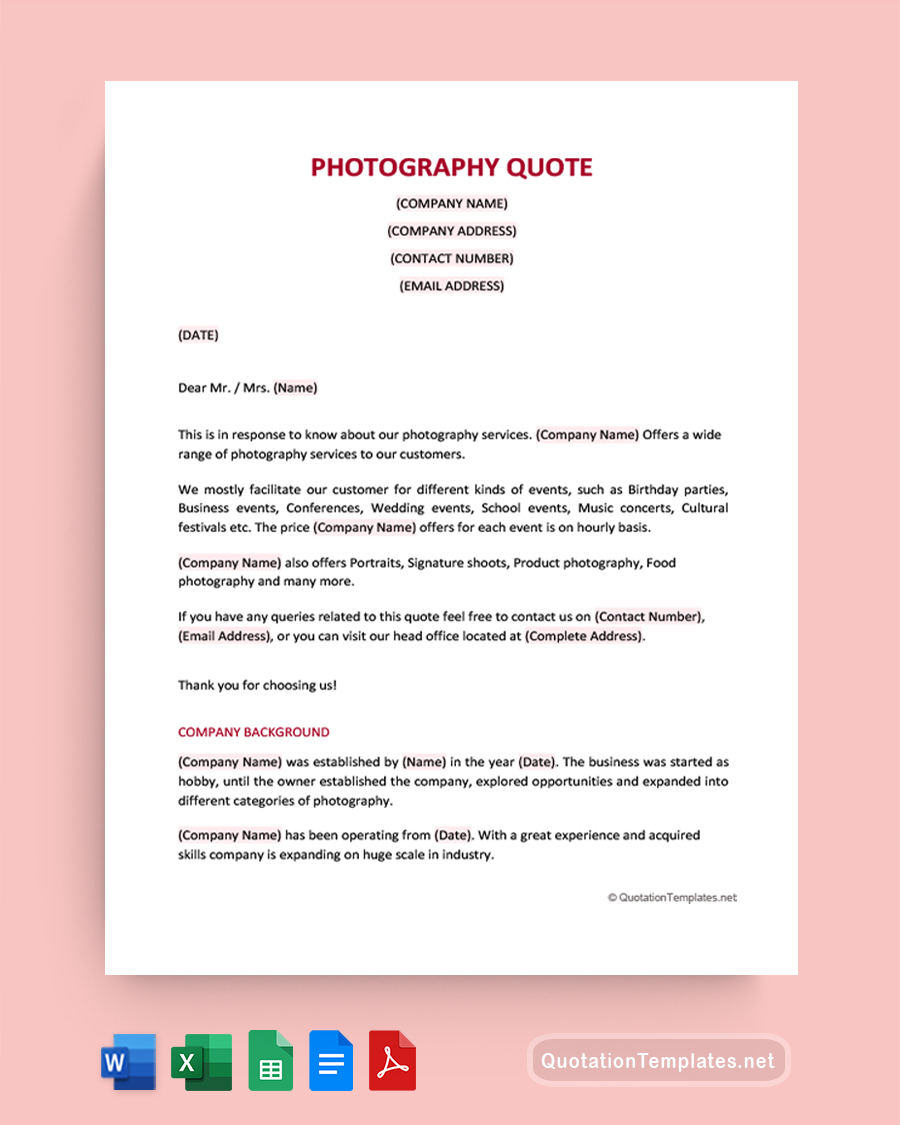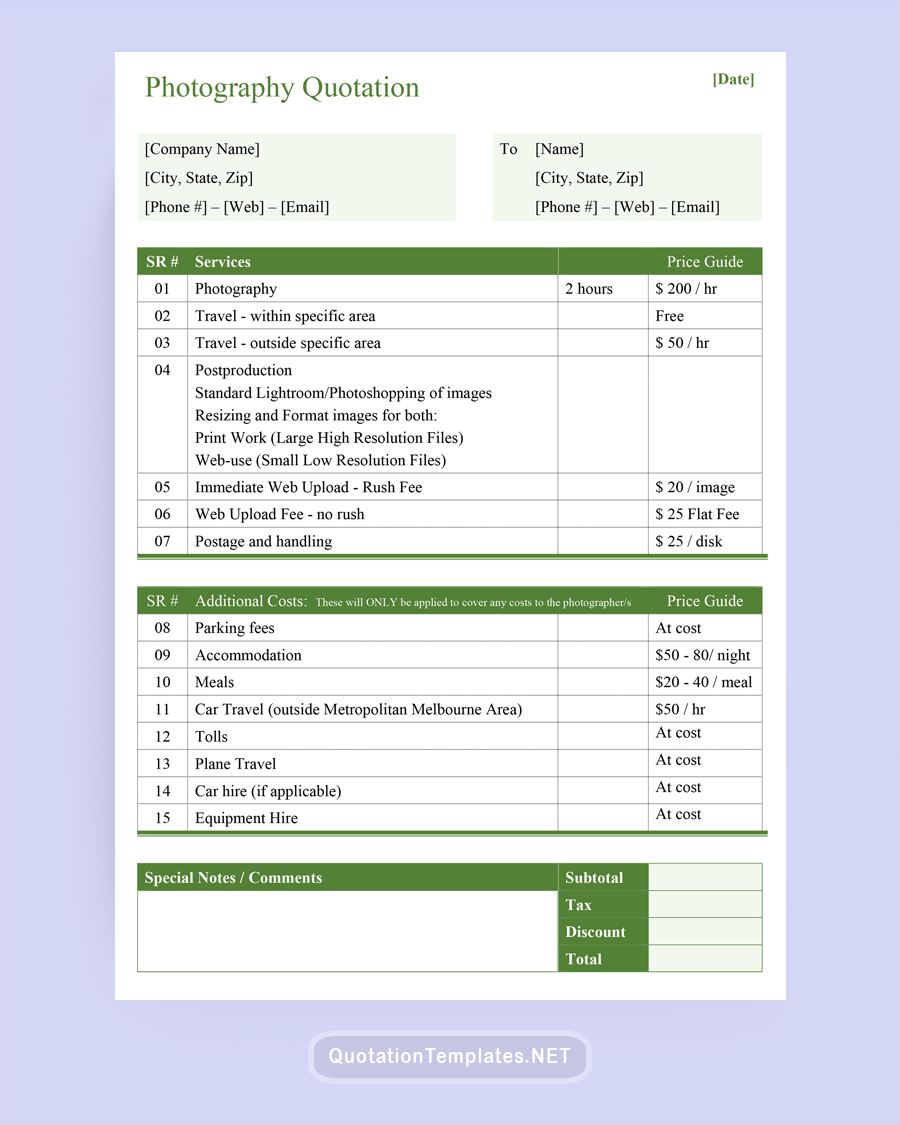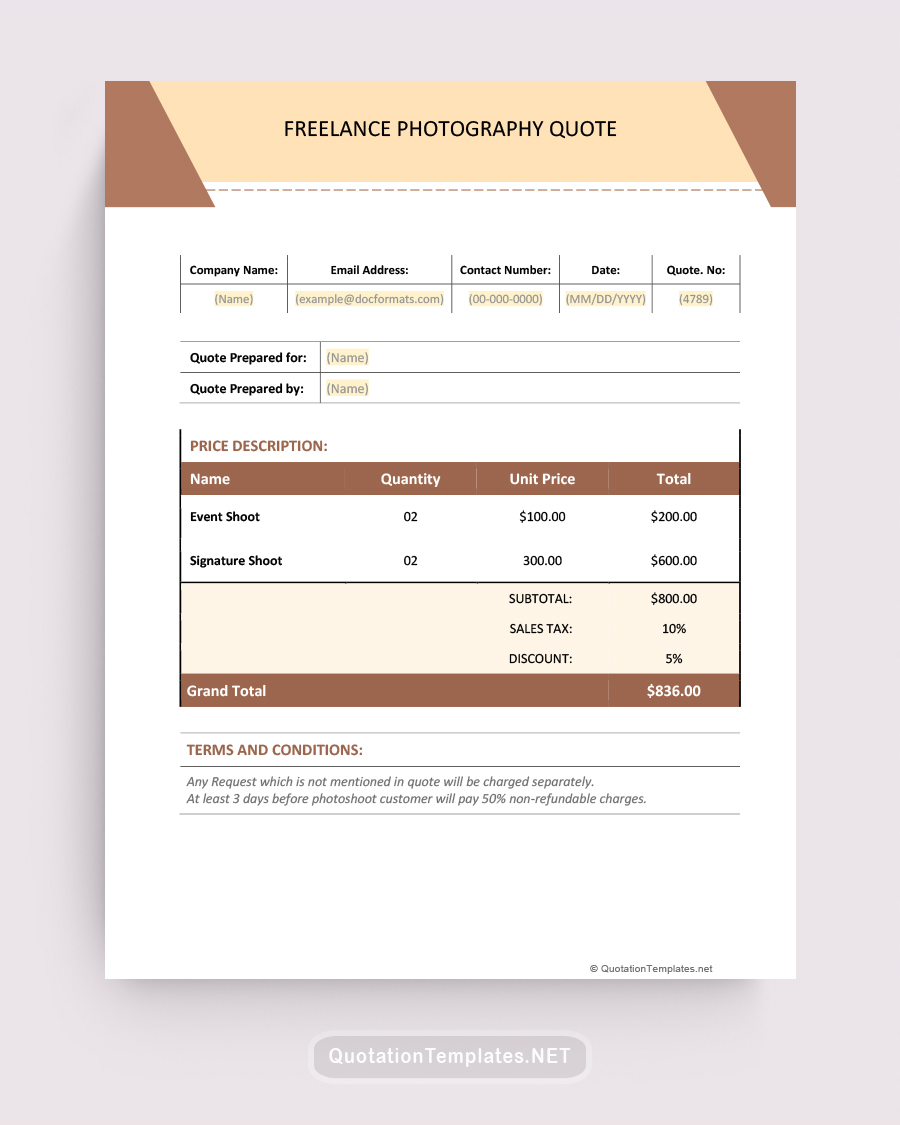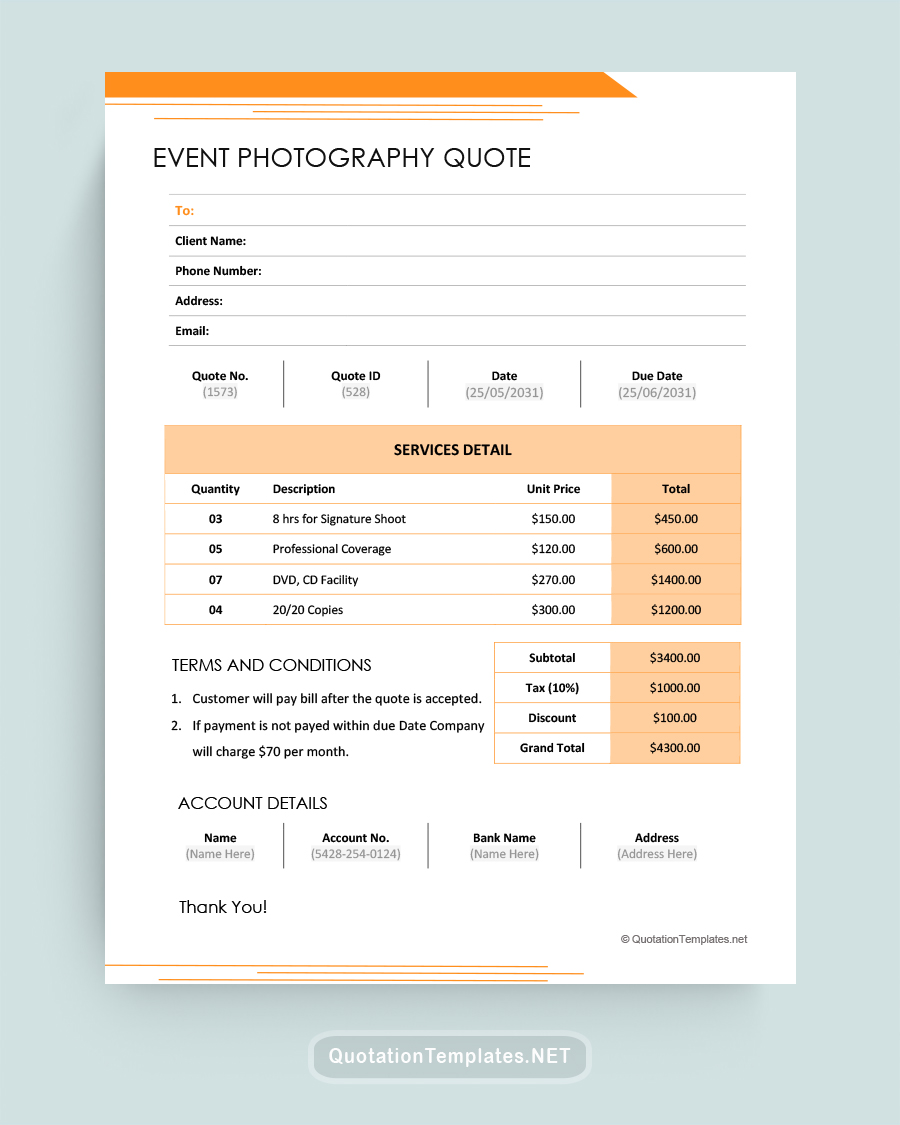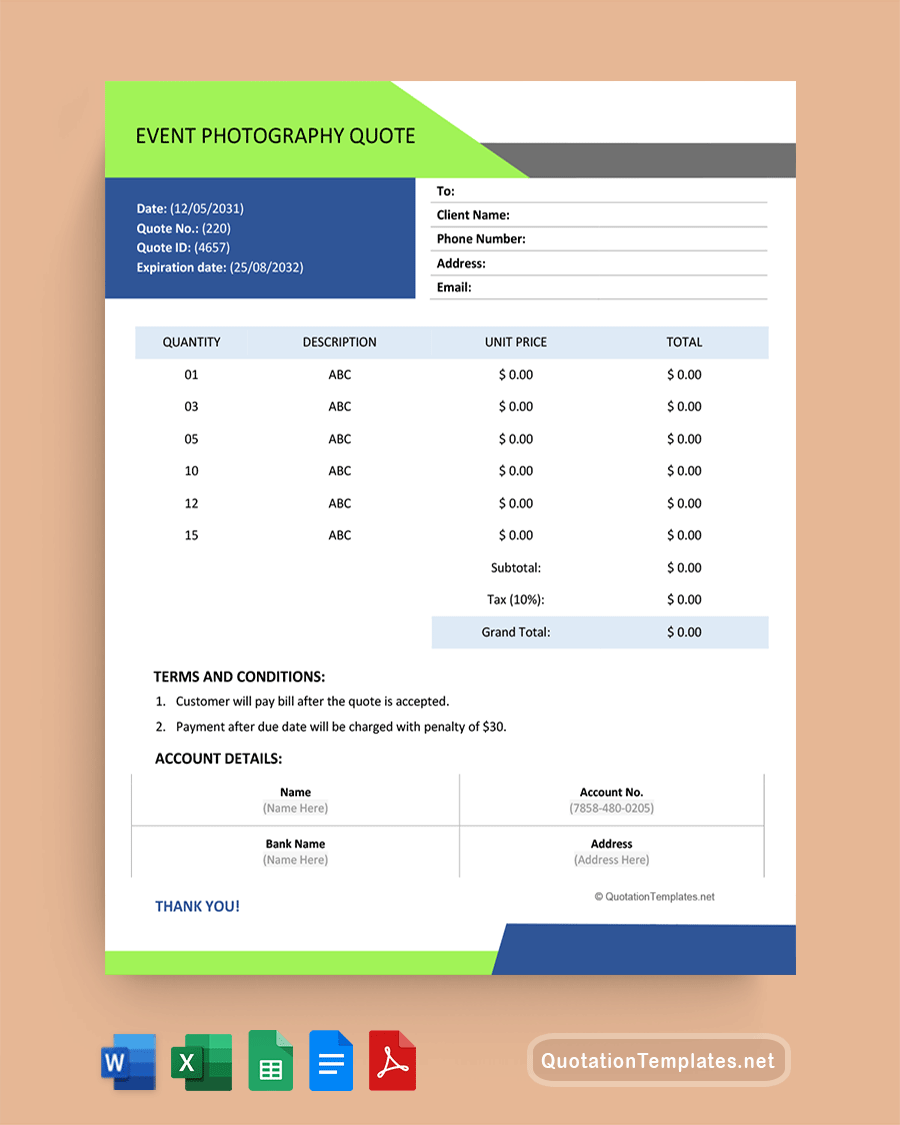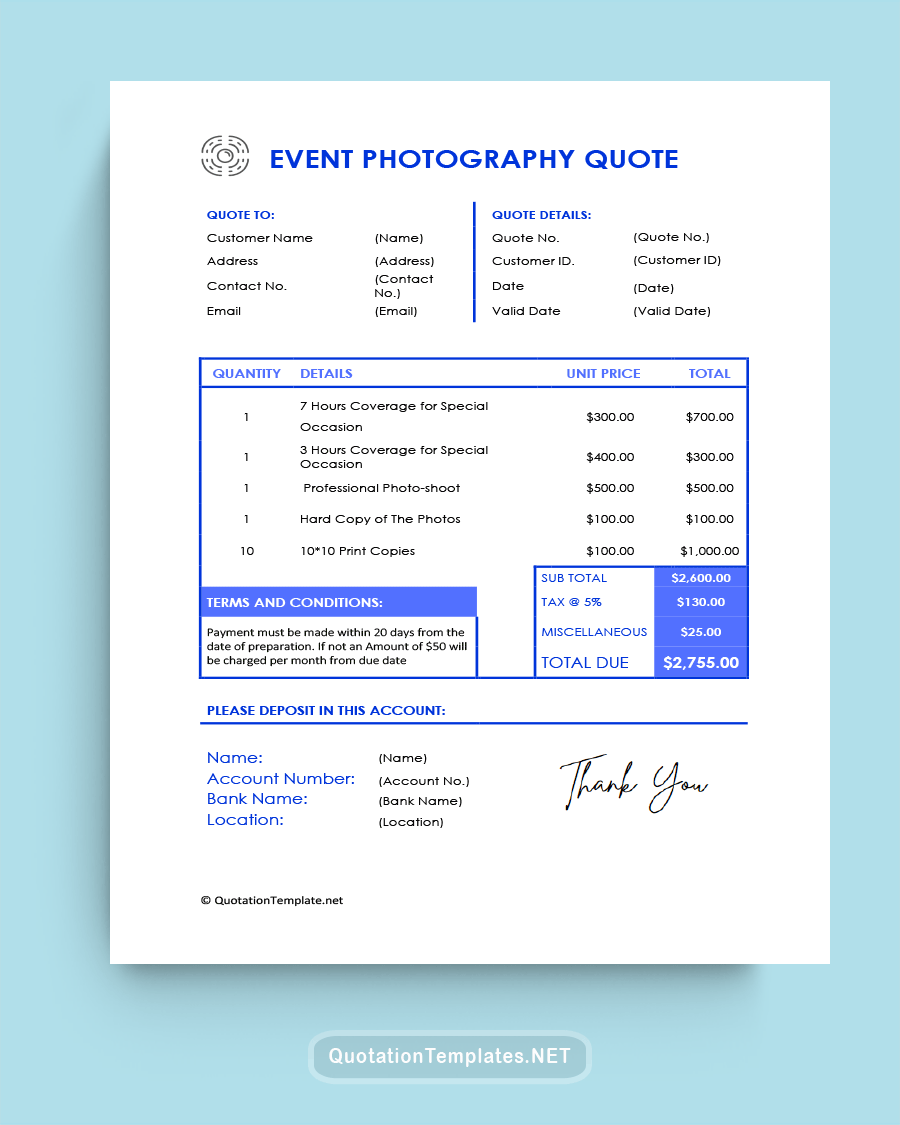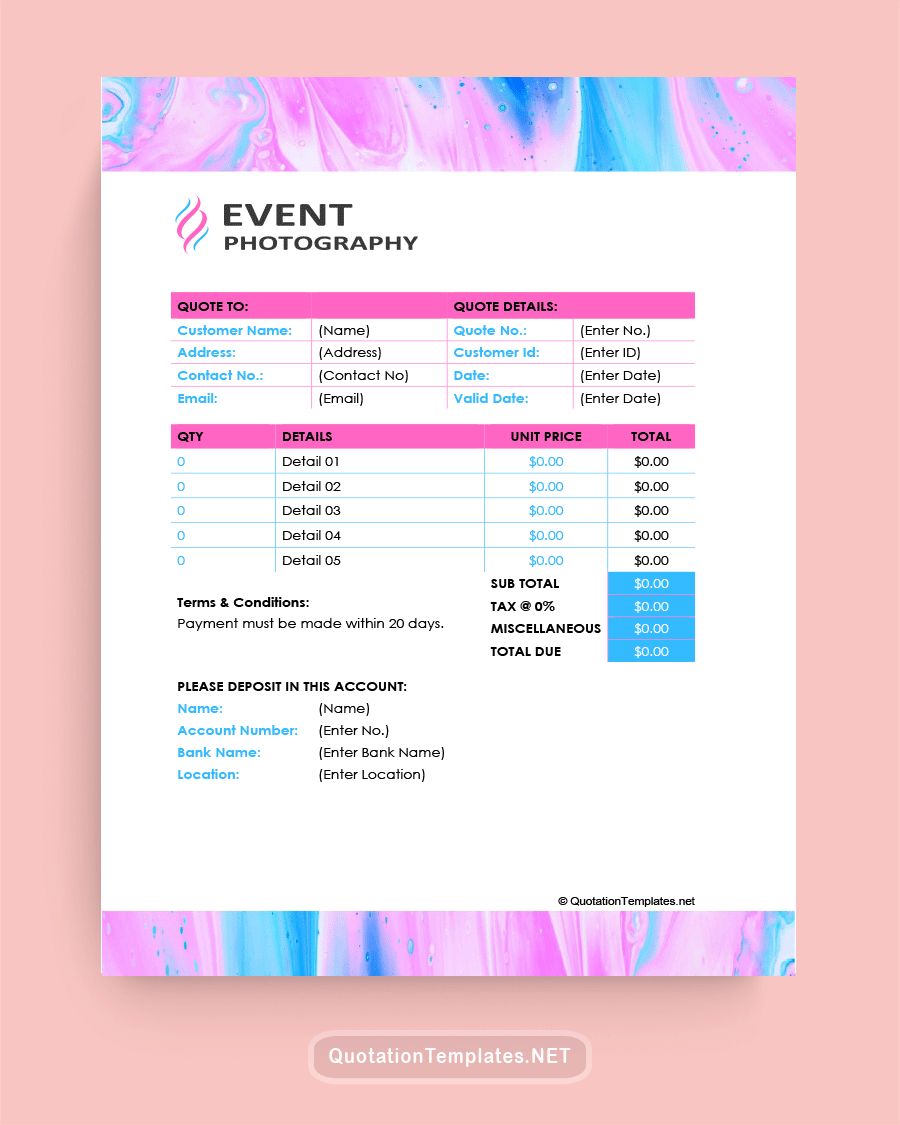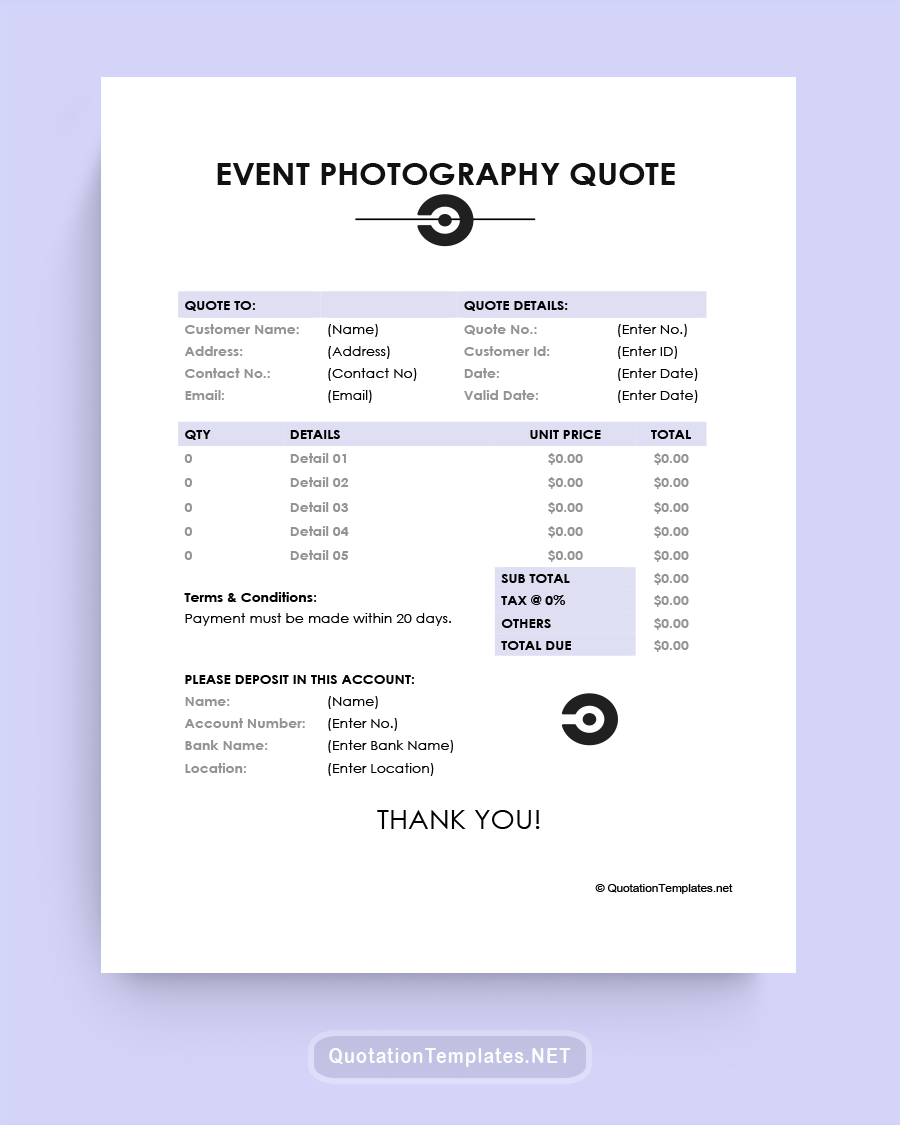Photography Quote Templates
A picture is a physical copy of memory. It captures the image of a moment in time and keeps it forever in frozen light. Good photos can help you remember the best or worst of times and share those feelings and impressions with other people. Photography as a business is all about keeping memories and recording events. It is valuable in many ways.
Almost all professional photographers are small business people, though other businesses employ a few. Learning how to price your work competitively is essential in any business, but for photography, it can be a little tricky. There are significant differences between beginning or student rates and long-time professional photographers. Moreover, the type of photos, time spent, equipment used, and location all impact the overall cost. However, that doesn’t mean the price is inconsistent, only based on what’s required for the job plus making a profit for your business. To get an idea of what that’s worth potential customers need to ask questions. That’s when a photography quote comes in handy.
What is a Photography Quote?
A photography quote is what a client or potential client asks you for when they inquire about the price of photography. This should reflect your costs, equipment and tools, travel time to the location or set materials (if you have an indoor photography business), repairs and parts, labor, and making a profit. Good photography is not cheap because the photographer knows its value. An easy-to-understand photography quote is a value-added, low-effort way to gain clients and look more professional.
What Is a Photography Quote Template?
A photography quote template is a tool that allows a photographer to quickly and easily generate a photography quote for their clients. People want to know how much they will pay to engage your services in concise, unambiguous terms. Asking for these quotes allows a potential customer to compare rates and services such as packages, ensuring the photographer looks professional, honest, and organized. A good photography quote template is easy to adjust for different styles of photography jobs and can be printed or emailed on demand. Think of it as a menu, but instead of showing what foods cost at a restaurant, it shows the hourly rates and packages you offer as a professional photographer.
Essential Elements of a Photography Quote Template
The essential elements of a photography quote template are simple. You need to provide basic information about your business and what services it offers. This is similar to any other hourly or flat-rate quote. The most significant difference is you and what you do. Below is a quick list to help you create your ideal photography quotes.
- Business Name- You can use your name, such as Jane Doe, Photographer, but most people register their businesses under a creative name like “Shutterspeed” or “Frozen Moments.” The choice is up to you, but you must provide a name.
- Contact information- The contact information should include a business address, phone number, email, and a website if you have one. Setting up a photography website is a great way to show off your skills and help bring in more clientele. Don’t forget to claim your google maps location and Yelp business so you come up in local searches.
- Date- Photography prices don’t last forever and are subject to change, so adding the date is essential.
- List of Services- This is an itemized list of your hourly options for different types of photography and any package deals you may have. Include any discounts or limited-time deals as separate items on the list.
- Cost of Services- You should have a set fee listed beside each service.
- Additional Options- If you offer duplicates or add-on options, you should note this separately.
- Quote Expiration- The cost of your services is bound to change, so be sure to list when the quote expires.
- Closing Statement- You can include a note at the bottom thanking people for their business if you like, but it’s not a requirement.
- Terms and Conditions- Like any business, you should have a contract for your services, which means having terms and conditions. Examples include the right to opt-out during a project if you are harassed or impeded from doing your job (especially useful for weddings where people will be getting drunk), and if/when the deposit is refundable, cancellation fees, and replacements for any damaged equipment. Hopefully, you won’t need those clauses, but it’s best to be fully prepared for any eventuality.
Tips For a Better Photography Quote
A photography quote should include everything a client needs to know and be clear enough for them t understand. There are a few tips to keep in mind that will help you create the most professional photography quote possible.
- Make a Logo- Whether you use a camera, cartoon image, favorite picture, or more abstract idea, a basic logo is something every business needs to help promote the brand. Use this at the top either as a large central image or opposite the name and contact information, put it on business cards, and add it as a watermark to invoices. If you aren’t sure what kind of logo to make, consider hiring a professional from a freelance site such as Fiverr. (https://www.fiverr.com/)
- Color Choices- You can stick to black and white if you prefer. Still, photography is a creative business, so using a single color or simple, complementary color scheme for details is more professionally acceptable than if you were, for example, a contractor. Look up the meanings of colors and how they make people feel. Don’t get too silly, and avoid using all primary colors unless you plan to photograph mainly children.
- Fonts- Most of your photography quotes’ text should be in the most straightforward, clearest font possible. Stick with Times New Roman or something equally basic for easy reading. However, as a creative business, you can have a little fun with the fonts on your logo and business name. Just remember to keep it legible so people understand what it says at a glance.
- Be Clear: People looking at your quote should know how many pictures to expect from their session.
- Update Regularly- As a professional, you must stay on top of the rate trends and adjust your prices accordingly. Off-season rates and package deals should be lower to help promote more bookings.
- Terms and Conditions- It is okay but not always necessary to have a whole page of terms and conditions. If you have extensive terms, use a separate sheet and staple it to the quote when giving out physical copies.
- Don’t Forget Your Assistants and Employees- Some photographers work together or have assistants for big jobs. If you bring more than one person to the event for work reasons, or you have someone who helps in development or the studio, you need to charge for their time as well.
- Gratuity- Remind people that tipping is standard. A tip often ranges from $50 to $100 but rarely totals more than 10% of the bill. You can include this as a note at the bottom.
How to Estimate a Photography Job
Estimating a photography job has two essential elements. First, what is the going rate in your area for equivalent work by similarly experienced professionals? Second, what does it cost you in tools, supplies, and time plus a profit for your work? Below is a simple chart that shows you what the going rates are for different types of photography.
- Minimums: Many photographers charge a minimum rate for their time equivalent to 1 to 2 hours. Doing this isn’t necessary, but it’s also relatively common.
- Mini Shoot: A 20 to the 30-minute session where you offer people anywhere from 5 to 15 completed images should cost $50 to $100
- Beginner or Student: $35 to $100 per hour
- Experienced Semi-Professional or Part-Timer: $50 to $175 per hour
- Professional: $75 to $300 per hour
- Experienced Reputable Professional: $250 to $500 per hour
- Package Deals: These should be 10% to 25% less than the hourly rate, but rarely less than the hourly minimums listed above
- Off-Season Discounts: 10% to 20% lower than during the busy season, but never less than the hourly minimums listed above
- Travel Fees: Gas and Time
- Additional Prints: Some customers will want duplicates. Set a reasonable fee for your time in creating these.
FAQs
Whether you are a new photography student or a seasoned professional looking to update your pricing model, there are some questions everyone needs answers to. Below are a few most frequently asked questions about pricing a photography business.
Photographers should charge based on their costs, labor, skill, and experience. Generally, a student or new photographer should charge near the low end of the spectrum at $35 to $100 per hour. That’s $105 – $300 for 3 hours, $150 – $400 for 4 hours, and $185 – $500 for 5 hours. The national average is $131 per hour. That’s $393 for 3 hours, $524 for 4 hours, and $655 for a 5-hour photo shoot. As a seasoned professional, you can expect to charge $200 – $350 per hour or more at the high end. That works out to $600 – $950 for 3 hours, $ $800 – $1300 for 4 hours and $1000 – $1650 for your 5 hour shoot.
There is more than one type of photoshoot. However, 30 minutes are enough for a single location photoshoot using one outfit. You can complete a basic set of family photos, some quick but beautifully framed graduation pictures, or a single outfit maternity shoot in this amount of time, depending on the circumstances, model(s), and photographer. Moreover, some photoshoots have to be finished quickly when outdoors because of natural light changes. This is especially relevant to twilight photos since sunrise and sunset fade quickly.
In most cases, a photographer should expect to shoot around 80 to 100 photographs per hour. However, that doesn’t mean that is what the client sees or keeps. Once they are developed, typically, the photographer narrows down the selection to around 40 or 50 of the best shots. The exact number a client receives will vary. Still, they should generally expect about 10 for a staged indoor shoot like family pictures or headshots, 20 for most semi-staged events like maternity and engagement shoots, and 15-30 for large unstaged events like weddings. The less control your photographer has, the more images they will take that come out imperfect.
There is a significant difference between a finished professional photograph and an amateur with an iPhone. It takes a knowledgeable eye to pick out a good shot that looks nice, and even then, your photographer will typically take multiple pictures to ensure the lighting is correct, there’s no blurred motion, and so on. No matter how many pictures you take as a photographer, the client shouldn’t be privy to all of them. After developing the photos, photographers dispose of any that don’t look good. Clients see an edited version of the pictures with no stereotypical problems like bad angles, closed eyes, etc. Ultimately the photographer only edits and delivers around 10-30 pictures per hour because those are the most precise, attractive, and visually stunning images that have been worked with to give the best possible clarity and other features.
A mini photoshoot is 20 to 30 minutes for a few quick photos. On average, a photographer charges $100 to $175 for these short shoots. It’s a little more than the cost of the typical booking for longer projects because there’s still the cost of equipment, travel time, and development, among other fees. However, you should charge less if you have less experience.
Final Thoughts
The value of photography is that it can capture memories to last a lifetime. Perhaps even more important, a picture allows people to share their memories with others in a way words cannot quite replicate. You can literally see through another person’s eyes. There’s nothing wrong with amateurs doing so-called spray and pray photography with their iPhones and making the best out of digital images. Still, nothing compares to the art of a professional. Pricing your photography business accordingly is essential for your work and other photographers. Underselling yourself will ultimately cost you, and it devalues everyone’s work. Meanwhile, overcharging will cost you clients. Following a standard price guide, checking comparable rates in your area, and having a good-quality photography quote on hand to print or email a potential client will add value and prevent confusion.
